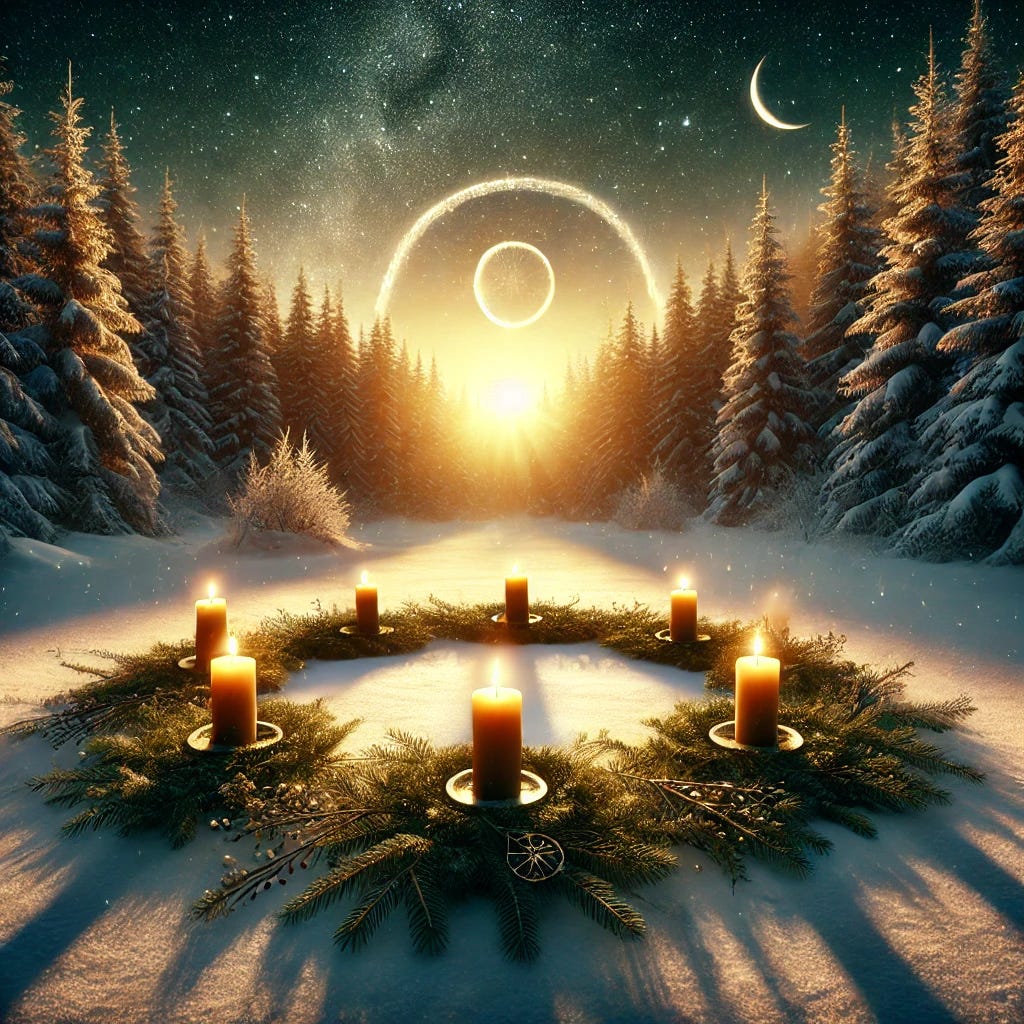The Winter Solstice
A Mythic Guide to Life’s Cycles and Renewal
“In the depth of winter, I finally learned that within me there lay an invincible summer.”
—Albert Camus
The winter solstice, the shortest day and longest night of the year, has long held profound significance in Western mythology. Rooted in the cycles of nature, it marks the moment when the sun’s decline halts, and the promise of brighter days begins. This ancient turning point is more than an astronomical event—it’s a mirror reflecting the cycles of darkness and renewal that shape human life. From Norse legends to Celtic traditions, the myths of the solstice reveal archetypal truths about transformation, resilience, and the importance of embracing the darkest nights to welcome the light.
By exploring the mythology of the winter solstice and connecting it to personal development, we can uncover profound wisdom for navigating life’s challenges and cycles of growth.
Western Mythology and the Winter Solstice
Western myths associated with the solstice revolve around death and rebirth, darkness and light, and the promise of renewal.
Norse Mythology: Balder and the Light
The Norse god Balder, a symbol of light and purity, is tragically killed due to Loki’s schemes. His death plunges the world into darkness, mirroring the diminishing sunlight before the solstice. Yet Balder’s resurrection, foretold in Ragnarok, speaks to the return of light and hope after the darkest times. For the Norse, this myth encapsulates the solstice’s promise: light will return, even in the bleakest winter.
Celtic Yule: The Battle of Oak and Holly Kings
In Celtic tradition, the solstice is a cosmic battle between the Oak King, representing light and growth, and the Holly King, embodying darkness and decay. At Yule, the Oak King triumphs, symbolizing the return of longer days. This tale reflects the solstice’s cyclical nature, where darkness is necessary but temporary, paving the way for renewal.
Roman Saturnalia: Order from Chaos
Saturnalia, celebrated in December, was a raucous festival honoring Saturn, the god of time and agriculture. During this period, societal roles were reversed, and order gave way to chaos—an acknowledgment of the uncertainty that darkness brings. As the festival concluded, order was restored, symbolizing the renewal of light and life.
These myths reflect an essential truth: darkness is not the end but a necessary precursor to light. They teach us that cycles of struggle and renewal are inevitable and offer hope during life’s metaphorical winters.
The Solstice as a Model for Personal Development
The winter solstice is not just a seasonal event; it’s a guide for navigating the cycles of personal growth. Life, like the seasons, moves through phases of darkness, introspection, light, and renewal. Understanding these cycles allows us to embrace both the hardships and the triumphs as part of our journey.
1. Embracing Darkness as a Teacher
Just as the longest night of the solstice is followed by the gradual return of light, our darkest moments often precede transformation. Western myths teach us that darkness—though daunting—is fertile ground for growth. The story of Balder’s death, for example, reminds us that loss and hardship are not permanent states but necessary steps toward renewal.
In personal development, darkness might manifest as periods of self-doubt, failure, or grief. These moments force us to confront our inner shadows and reevaluate our path. The solstice reminds us that these experiences, while challenging, are integral to our growth. They provide the stillness and reflection needed to cultivate resilience and clarity.
2. The Cyclical Nature of Growth
The winter solstice reflects the cyclical nature of life: death leads to rebirth, and endings give rise to beginnings. This cycle mirrors the stages of personal transformation, often mapped as a Hero’s Journey. In Joseph Campbell’s model, the hero must descend into the abyss—the darkest point—before emerging transformed.
For us, this might mean grappling with a career setback, a personal loss, or an existential crisis. These are not endpoints but thresholds to a new phase. The solstice teaches us to trust the process, knowing that growth is not linear but cyclical. Like the Oak King reclaiming his crown, we too can rise stronger after periods of dormancy.
3. Finding Light in Connection and Ritual
Western solstice traditions emphasize communal gatherings and rituals, from the lighting of the Yule log to the sharing of Saturnalia feasts. These rituals remind us of the importance of connection and intention during dark times.
In personal growth, rituals can anchor us during uncertainty, providing a sense of purpose and continuity. Journaling, meditating, or creating symbolic acts of renewal—like lighting a candle to represent the return of hope—can help us navigate our inner winters. The solstice urges us to find and nurture light, even in the darkest moments, through both community and personal reflection.
Lessons for the Modern Hero
The winter solstice offers profound lessons for personal development:
Darkness is a Phase, Not a Destination: Hardship is inevitable, but like the solstice night, it will pass. Trusting in the cyclical nature of life can help us endure.
Growth Requires Stillness: Just as winter offers a time for nature to rest, our lives need moments of introspection. Solstice myths encourage us to embrace these pauses as essential for renewal.
Light Returns, Gradually: Transformation is not immediate. Like the sun’s slow return after the solstice, personal growth requires patience and persistence.
Conclusion: Rebirth Awaits
The winter solstice, steeped in myth and meaning, is a timeless reminder of life’s cycles. Western traditions—from Balder’s resurrection to the Oak King’s triumph—illustrate the eternal dance of darkness and light, despair and hope. These myths offer a roadmap for our own journeys, showing us how to navigate life’s challenges with grace and resilience.
By embracing the solstice as a metaphor for personal growth, we can find meaning in life’s winters and trust in the promise of renewal. The light, though distant, always returns—both in the heavens and in our hearts.


